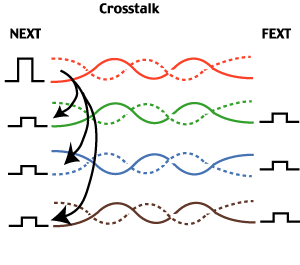 | ||
In electronics, crosstalk is any phenomenon by which a signal transmitted on one circuit or channel of a transmission system creates an undesired effect in another circuit or channel. Crosstalk is usually caused by undesired capacitive, inductive, or conductive coupling from one circuit, part of a circuit, or channel, to another.
Contents
In cabling
In structured cabling, crosstalk can refer to electromagnetic interference from one unshielded twisted pair to another twisted pair, normally running in parallel.
In audio
In stereo audio reproduction crosstalk can refer to signal leaking across from one program channel to another, reducing channel separation and stereo imaging. This is an electrical effect and can be quantified with a crosstalk measurement.
Interchannel crosstalk applies between the two channels of a stereo system, and is usually not very important on modern systems, though it was hard to keep below the desired figure of -30 dB or so on vinyl recordings and FM radio.
Crosstalk between channels in mixing consoles, and between studio feeds is much more of a problem, as these are likely to be carrying very different programmes or material.
Crosstalk measurement is made on audio systems to determine the amount of signal leaking across from one channel to another.
The IBA drew up a weighting curve for use in crosstalk measurement that gives due emphasis to the subjective audibility of different frequencies, as shown here. This is still in use, despite the demise of the IBA, and in the absence of any international standards is worth adopting.
Other examples
In telecommunication or telephony, crosstalk is often distinguishable as pieces of speech or signaling tones leaking from other people's connections. If the connection is analog, twisted pair cabling can often be used to reduce the effects of crosstalk. Alternatively, the signals can be converted to digital form, which is much less susceptible to crosstalk.
In wireless communication, crosstalk is often denoted co-channel interference, and is related to adjacent-channel interference.
In integrated circuit design, crosstalk normally refers to a signal affecting another nearby signal. Usually the coupling is capacitive, and to the nearest neighbor, but other forms of coupling and effects on signal further away are sometimes important, especially in analog designs. See signal integrity for tools used to measure and prevent this problem, and substrate coupling for a discussion of crosstalk conveyed through the integrated circuit substrate. There are a wide variety of possible fixes, with increased spacing, wire re-ordering, and shielding being the most common.
In full-field optical coherence tomography, "crosstalk" refers to the phenomenon that due to highly scattering objects, multiple scattered photons reach the image plane and generate coherent signal after traveling a pathlength that matches that of the sample depth within a coherence length.
In stereoscopic 3D displays, "crosstalk" refers to the incomplete isolation of the left and right image channels so that one leaks or bleeds into the other - like a double exposure, which produces a ghosting effect.
